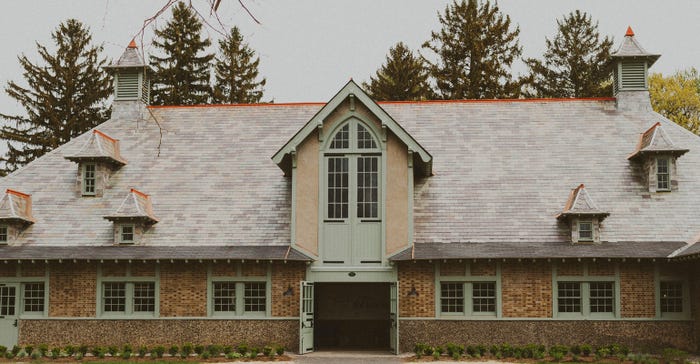August 31, 2021

Central New York and the Finger Lakes region have become well-known for craft beverages and local wineries.
To stand out above the crowd, a particular atmosphere and unique ambiance are needed. That’s been the goal of brewery owners Stacey and Derek Edinger. The couple have transformed a former sheep barn into Brewery Ardennes in Geneva, N.Y., a business inspired by their travels to Belgium.
“We’re largely emulating the small agrarian communities we found,” Stacey says. “The Ardennes region [in Belgium] is on the eastern border. It’s a little bit more forested, but the climate is similar.”
The Finger Lakes and Ardennes regions share an emphasis on handcrafted, farm-sourced goods, she says, and the old sheep barn that houses the brewery is quite unique.
Influenced by immigrants
The building’s cobbles, slate roof and architecture are unlike any other buildings in the area. Stacey believes that its European influences likely come from immigrant construction workers.
The property was originally a Guernsey farm. In 1909, Katherine Bell Lewis, a wealthy woman from Buffalo, purchased the property. A young widow, she threw herself into developing the property as Bellwood Farms, a gift to her newly married son, Alfred.
Lewis eventually built a 5,000-square-foot “summer cottage” on the property where she could stay and oversee the farm. She added the sheep barn to the complex, forming a square of buildings around a courtyard. She bought more land until the sprawling farm, then on the edge of Geneva, included thousands of acres.
Lewis became a prominent breeder of Shropshire sheep, importing stock from England and eventually owning 2,000 head.
Fires in 1912 and 1930 destroyed most of the buildings on the property, except for the portion of the sheep barn that the Edingers now use for the brewery, and also the farm manager’s residence, which is their home. The brewery represents only one-third of the barn’s original 15,000 square feet. The Edingers own 8 acres of the original Bellwood Farms.
The property is unusual because of its man-made streams for irrigation and its 10-foot-deep-by-100-foot-long buried cistern, dug to supply water to several fire hydrants. Apparently, Lewis feared that fire would destroy her farm again.
A few hydrants still exist on the property. Stacey says that they work the landscaping around them, although the hydrants are likely no longer functional.
Costly renovation
The building’s unique traits made renovating more challenging. The Edingers bought the property in 2019 from the Poole family, who used it as a private residence from 1973 and sold off parcels over the years from the original Bellwood Farms property.
The Edingers invested a little more than $2 million, including their own funds and loans.
Lewis had workers save stones taken from the property to be crushed to silver dollar sizes to use as cobblestones for the building.
“It was hard to find masons who do this kind of work,” Stacey says. “We still have no record of why she liked this kind of French-Roman architecture.”
Only the sheep barn was built in that style, as indicated by historic photos of the other buildings.
“The slate roof is original on the barn, and the slate and pitch of the roof is much grander than the house,” Stacey says. “The tiles on the barn are one-third larger and thicker than what is on the house. Finding someone who specializes in slate was an interesting challenge during the restoration.”
The “cottage,” standing a half-mile from the brewery, is now a private residence. Its distance from the farm buildings spared it from the fires.
The Edingers also had to repair the roof, hang two replica doors — the remaining doors and all the windows are original — and run utilities to the barn, as it never had any.
“We had to build the entire infrastructure,” Stacey says. “It was a shell.”
Preserving history, giving new life
To remain eligible to be listed on the National Historic Register, perhaps a future endeavor, the Edingers have tried to keep as much of the barn as original as possible. But that’s also meant that they could not meet modern energy standards such as insulation and double-hung windows.
Their goal was to update but not remove the history of the property. Stacey believes they have achieved that goal, as well as surprised some locals with their work.
“The previous owners had a lot of vegetation growing around the barn,” she says. “We have a lot of people who are Geneva natives who’ve gone up and down our road their entire lives that didn’t know what was back here. We see them out the front windows. They get out of the car, walk up and wonder, ‘What is this?’ A lot of people are taken aback.”
Some locals assume the Edingers constructed the building themselves because they have never seen it. But giveaways such as wavy window glass and worn woodwork tell the real story.
“It’s part of the character,” Stacey says. “It didn’t have to be perfect. We wanted it to feel patinaed.”
Derek has been brewing beer for 25 years and offers 13 varieties that use local barley and wheat. He distributes spent grain to local farms for use as livestock feed. The brewery opened on May 19, 2020. The couple hopes to produce 1,200 barrels annually and offer limited distribution in the region.
Sergeant writes from central New York.
About the Author(s)
You May Also Like




